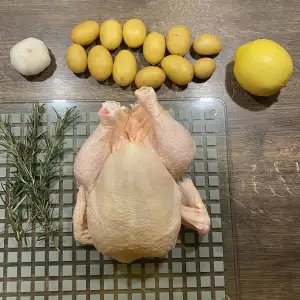Master the Art of Making Risotto: Step-by-Step Recipe Guide

Risotto, a classic Italian dish, is a culinary masterpiece that has captured the hearts and palates of food enthusiasts around the world. This creamy and comforting rice dish is known for its rich flavors and velvety texture. Originating from Northern Italy, risotto has become a staple in Italian cuisine and is now enjoyed in various forms across different cultures.
The key to a perfect risotto lies in its preparation method. Unlike other rice dishes where the rice is boiled separately, risotto involves cooking the rice slowly by gradually adding flavorful stock. This technique allows the rice to release its starches, creating a luscious and creamy consistency.
Traditionally made with Arborio or Carnaroli rice, risotto can be customized with an array of ingredients such as vegetables, seafood, meat, or cheese. The possibilities are endless when it comes to flavor combinations, making risotto a versatile dish that can cater to any palate.
Whether you're a seasoned chef or an aspiring home cook, mastering the art of making risotto will elevate your culinary skills and impress your guests. In this step-by-step recipe guide, we will delve into each stage of preparing risotto, from sautéing aromatics to adding final ingredients. So let's roll up our sleeves and embark on a journey to create the perfect bowl of creamy goodness!
Ingredients for Risotto
To create a delicious and creamy risotto, you will need the following ingredients:
1. Arborio Rice: This short-grain rice is essential for its high starch content, which gives risotto its signature creamy texture.
2. Stock: Choose a flavorful stock such as chicken, vegetable, or mushroom to enhance the taste of your risotto. Homemade stock is always preferred, but store-bought can work too.
3. Aromatics: Sautéing aromatics like onions, garlic, and shallots adds depth of flavor to your dish.
4. White Wine: A dry white wine like Chardonnay or Pinot Grigio adds acidity and complexity to the risotto.
5. Butter: Butter enriches the risotto and adds a silky smoothness to the final dish.
6. Parmesan Cheese: The nutty and salty flavor of Parmesan cheese complements the creaminess of the risotto.
7. Seasonings: Salt and pepper are essential for enhancing the flavors in your risotto. You can also add herbs like thyme or parsley for extra freshness.
Make sure to gather these ingredients before starting your risotto adventure!
Preparing the Stock
A flavorful stock is the foundation of a delicious risotto. To make the stock, you will need a combination of vegetables, herbs, and sometimes meat. The most common vegetables used are onions, carrots, and celery. You can also add garlic, leeks, and mushrooms for added depth of flavor.
Start by washing and roughly chopping the vegetables. In a large pot, heat some olive oil over medium heat. Add the vegetables and sauté them until they start to soften and release their aromas. This step helps to enhance the flavors in the stock.
Next, add water or chicken/vegetable broth to cover the vegetables completely. Bring the mixture to a boil and then reduce the heat to low. Let it simmer for at least 30 minutes to allow all the flavors to meld together.
After simmering, strain the stock through a fine-mesh sieve or cheesecloth into another pot or bowl. Discard the solids and keep only the liquid. Your homemade stock is now ready to be used in your risotto recipe.
Alternatively, you can use store-bought stocks or broths if you're short on time. Just make sure to choose high-quality ones that are low in sodium for best results.
Remember that a good stock is essential for achieving a rich and flavorful risotto, so take your time with this step and don't be tempted to skip it!
Sautéing the Aromatics
Once you have your stock simmering on the stove, it's time to start sautéing the aromatics. This step is crucial for building flavor in your risotto. In a large, heavy-bottomed saucepan, melt some butter or heat some olive oil over medium heat.
Next, add finely chopped onions and garlic to the pan. Sauté them until they become translucent and fragrant, about 2-3 minutes. The onions will provide a sweet base note while the garlic adds a savory depth to your risotto.
For an extra burst of flavor, you can also add other aromatics like shallots, leeks, or even diced carrots. These ingredients will infuse their unique flavors into the dish and elevate its taste profile.
Remember to stir the aromatics frequently to prevent them from burning. You want them to soften and release their flavors without any charred bits.
Once your aromatics are sautéed to perfection, it's time to move on to the next step: adding the rice and toasting it. This step will help achieve that signature creamy texture that makes risotto so irresistible.
Adding the Rice and Toasting
Once your aromatics are sautéed to perfection, it's time to add the star of the show – the rice. Arborio or Carnaroli rice are commonly used for risotto due to their high starch content, which gives risotto its creamy texture.
Add the rice to the pan and stir it around, ensuring that each grain is coated in the aromatic oil. This step is crucial as it helps toast the rice, enhancing its nutty flavor and creating a protective layer around each grain.
Continue stirring for about 2-3 minutes until you notice that the edges of the rice grains become translucent. This indicates that they are properly toasted and ready to absorb all the flavors we'll be adding later on.
Toasting the rice not only adds depth of flavor but also helps prevent it from becoming mushy during cooking. So take your time with this step and enjoy watching as your risotto starts to come together beautifully.
Adding the Wine
6. Adding the Wine
Once the rice is toasted, it's time to add a generous splash of wine. This step not only adds depth of flavor but also helps to deglaze the pan, releasing any browned bits stuck to the bottom.
Choose a dry white wine like Chardonnay or Sauvignon Blanc, which will complement the creamy texture of risotto. Pour in about 1/2 cup of wine and stir continuously until it is absorbed by the rice.
The alcohol will evaporate during cooking, leaving behind a subtle tang that enhances the overall taste. Be sure to use good quality wine as it can greatly impact the final result.
Adding the wine at this stage infuses the rice with its essence, creating a rich and complex base for your risotto. It's an essential step that shouldn't be skipped.
Now that the wine has been absorbed, we can move on to gradually adding the stock, which will further enhance the flavors and bring our risotto to perfection.
Gradually Adding the Stock
Once the aromatics are sautéed to perfection, it's time to start adding the stock. This step is crucial in achieving that creamy and velvety texture that makes risotto so irresistible. Start by ladling in a small amount of warm stock into the pan with the sautéed aromatics and rice.
Allow the rice to absorb the stock while stirring gently with a wooden spoon. As the liquid gets absorbed, continue adding more stock, one ladleful at a time. The key here is to add just enough stock for the rice to cook evenly without becoming too dry or soupy.
Keep stirring gently and adding more stock as needed until the rice is cooked al dente – tender but still firm to the bite. The process of gradually adding stock should take about 20-25 minutes, depending on the type of rice used.
Remember to maintain a gentle simmer throughout this process, allowing each addition of stock to be absorbed before adding more. This slow and gradual method ensures that each grain of rice absorbs the flavors from the stock, resulting in a rich and flavorful risotto.
Be patient during this step as it requires constant attention and care. It may seem tedious, but trust me, it's worth it for that perfect bowl of creamy goodness at the end.
Next up: testing for doneness!
Stirring and Simmering
Once you have added the wine and it has been absorbed by the rice, it's time to start adding the stock. Using a ladle, add one or two ladles of hot stock to the rice mixture. Stir continuously with a wooden spoon until the liquid is almost completely absorbed. This process helps release the starch from the rice, giving risotto its creamy texture.
Continue adding more stock, one or two ladles at a time, stirring constantly and allowing each addition to be absorbed before adding more. The stirring motion helps to coax out the starches and create that velvety consistency that makes risotto so comforting.
Maintain a gentle simmer throughout the cooking process. The heat should be low enough that the liquid doesn't evaporate too quickly but high enough to keep everything cooking steadily. This gradual addition of stock and constant stirring will ensure even cooking and prevent any sticking or burning on the bottom of the pan.
Remember to taste as you go along. You want your risotto to be al dente, with a slight bite to it. It should not be mushy or overly soft. Adjust seasoning if needed by adding salt and pepper as desired.
The stirring and simmering process will take around 20-25 minutes in total, depending on the type of rice used and your desired level of doneness. Be patient and enjoy this meditative part of making risotto as you watch your dish transform into a creamy masterpiece.
Testing for Doneness
Once you have been simmering the risotto for about 15-18 minutes, it's time to test for doneness. The rice should be cooked al dente, meaning it should still have a slight bite to it. Take a spoonful of the risotto and taste it to check the texture.
The grains should be tender but not mushy. If they are still too firm, continue cooking and adding more stock as needed. Keep in mind that the risotto will continue to cook even after you turn off the heat, so it's better to slightly undercook it at this stage.
If the rice is cooked to your liking, remove the pot from the heat and proceed with adding the final ingredients. Remember that risotto should have a creamy consistency, so if it looks too dry, you can add a little more stock or hot water before serving.
Testing for doneness is crucial in achieving the perfect texture for your risotto. It ensures that each grain of rice is cooked just right and maintains its shape while being soft and creamy on the inside. So take your time and taste along the way until you reach that ideal balance of tenderness and firmness in every bite.
Adding the Final Ingredients
Once the rice is cooked to perfection, it's time to add the final ingredients to elevate the flavors of your risotto. This is where you can get creative and add your personal touch.
First, stir in a generous amount of grated Parmesan cheese. The creamy and nutty flavor of Parmesan adds richness to the dish. Stir until the cheese melts completely into the risotto, creating a velvety texture.
Next, add a knob of butter for extra creaminess. The butter will melt into the risotto, giving it a luxurious finish and enhancing its silkiness.
To bring a burst of freshness and color, sprinkle some chopped fresh herbs like parsley or basil over the risotto. These herbs not only add vibrant green hues but also lend their aromatic flavors to the dish.
Finally, season with salt and pepper according to your taste preferences. Be careful not to oversalt as Parmesan already adds a salty element.
Give everything one last gentle stir to incorporate all the final ingredients evenly throughout the risotto.
Now that you've added these finishing touches, your risotto is ready to be enjoyed! Serve it immediately while it's still hot and at its best. The creamy consistency and complex flavors will surely impress your guests.
Remember, adding these final ingredients is crucial for achieving an outstanding risotto that bursts with flavor. So don't skip this step and let your culinary creativity shine through!
Resting and Serving
Once the risotto is cooked to perfection, it's important to let it rest for a few minutes before serving. This allows the flavors to meld together and the rice to absorb any remaining liquid. During this resting period, cover the pot with a lid or some foil to keep it warm.
When you're ready to serve, give the risotto a final stir to loosen it up. The texture should be creamy and slightly loose, with each grain of rice maintaining its shape. If the risotto seems too thick, you can add a little more stock or hot water to thin it out.
Garnish your risotto with some freshly grated Parmesan cheese and a sprinkle of chopped fresh herbs like parsley or basil. The cheese adds a rich and nutty flavor while the herbs provide a refreshing touch.
Serve the risotto immediately in warmed bowls or plates. It's best enjoyed while still hot, as this is when all the flavors are at their peak. Pair it with a crisp white wine or even a light-bodied red for a truly satisfying meal.
Remember that risotto is meant to be eaten right away as it tends to lose its creamy texture upon cooling. So gather your loved ones around the table and savor every spoonful of this comforting Italian dish.
Tips for Perfect Risotto
1. Use the right type of rice: Arborio, Carnaroli, or Vialone Nano are the best choices for risotto as they have a high starch content, which gives risotto its creamy texture.
2. Toast the rice before adding liquid: This step helps to seal in the flavors and gives the dish a nutty taste. Stir the rice constantly over medium heat until it becomes translucent.
3. Use homemade stock: Homemade stock adds depth and richness to your risotto. If you don't have time to make your own, use a good quality store-bought stock.
4. Add the stock gradually: Adding the stock little by little allows the rice to absorb it slowly, resulting in a creamy consistency. Add about 1/2 cup of hot stock at a time and stir until absorbed before adding more.
5. Stir constantly: Stirring is crucial for releasing starch from the rice and creating that creamy texture. It also prevents sticking and ensures even cooking.
6. Don't overcook: Risotto should be al dente, with a slight bite to it. Be mindful of cooking time and taste frequently to avoid mushy or undercooked grains.
7. Finish with butter and cheese: Just before serving, add a knob of butter and grated Parmesan cheese to enrich the flavor and create a velvety finish.
8. Let it rest: Allow your risotto to rest for a few minutes after cooking to allow all the flavors to meld together.
By following these tips, you'll be able to master the art of making perfect risotto every time!
Variations and Flavor Combinations
Risotto is a versatile dish that can be customized with various ingredients to create unique flavors. Here are some popular variations and flavor combinations to try:
1. Mushroom Risotto: Add sautéed mushrooms, such as cremini or porcini, for an earthy and rich flavor. Finish with a sprinkle of freshly grated Parmesan cheese.
2. Seafood Risotto: Incorporate seafood like shrimp, scallops, or mussels into your risotto for a taste of the ocean. A squeeze of lemon juice and a handful of chopped fresh herbs will enhance the flavors.
3. Asparagus Risotto: Use tender asparagus spears, blanched and cut into small pieces, to add a vibrant green color and a delicate taste to your risotto.
4. Butternut Squash Risotto: Roast cubes of butternut squash until caramelized and tender, then fold them into the risotto along with some sage leaves for a comforting fall-inspired dish.
5. Tomato and Basil Risotto: Stir in diced tomatoes and fresh basil leaves for a burst of freshness. Top with mozzarella cheese for an Italian twist.
6. Truffle Risotto: For an indulgent treat, drizzle truffle oil over your finished risotto or shave truffles on top for an exquisite aroma and flavor.
7. Spinach and Feta Risotto: Add wilted spinach leaves and crumbled feta cheese to create a creamy and tangy combination that is both nutritious and delicious.
Remember, these are just suggestions, so feel free to experiment with different ingredients according to your preferences. The key is to balance flavors while keeping the creamy texture intact. Get creative in the kitchen and enjoy the endless possibilities that risotto offers!
In conclusion, mastering the art of making risotto is a rewarding and delicious endeavor. With its creamy texture and rich flavors, risotto has become a beloved dish around the world. By following this step-by-step recipe guide, you can create a perfect risotto every time.
Remember to use high-quality ingredients and take your time while preparing each step. The key to a successful risotto lies in the slow cooking process, allowing the rice to absorb the flavors of the stock and other ingredients.
Experiment with different variations and flavor combinations to create unique and exciting risotto dishes. Whether you prefer a classic mushroom risotto or want to explore more adventurous options like seafood or vegetable risotto, there are endless possibilities to satisfy your taste buds.
So gather your ingredients, prepare your stock, sauté those aromatics, and get ready to embark on a culinary journey that will impress both yourself and your guests. Mastering the art of making risotto will not only elevate your cooking skills but also bring joy and satisfaction to every flavorful encounter.
Published: 28. 01. 2024
Category: Recipes



